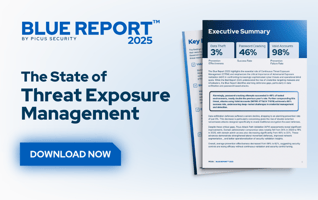When Credentials Fail: Password Cracking and Compromised Accounts
For security professionals, it’s easy to get caught up in sophisticated threats like malware, ransomware, and zero-day exploits. Yet, the most impactful and persistent attacks often rely on one of the oldest methods in the adversary playbook, compromised credentials. The Blue Report 2025 demonstrates that password cracking and the abuse of valid accounts remain major blind spots in enterprise defenses, allowing attackers to bypass even well-configured security controls with surprising ease.
Across over 160 million attack simulations, Picus Labs observed that password cracking succeeded in 46% of tested environments, nearly doubling the rate from the previous year. Equally concerning, attacks using Valid Accounts (MITRE ATT&CK T1078) had a 98% success rate, showing how easily attackers can leverage stolen credentials to move laterally, escalate privileges, and exfiltrate sensitive data. These findings highlight a critical vulnerability. Security teams may believe security controls are working, yet attackers continue to exploit weak or mismanaged credentials to bypass defenses silently.
Why Cracked Passwords and Valid Accounts Are a Hacker’s Best Friend
Compromised credentials are an exceptionally effective attack vector because they allow adversaries to blend in with legitimate activity. Unlike malware or ransomware that might trigger alerts, attacks using valid accounts often look like normal user behavior, making detection difficult. Once inside the network, attackers can escalate privileges, move laterally across systems, disable logging, and exfiltrate data all without raising alarms.
Infostealers have amplified this risk, evolving from opportunistic tools into sophisticated, targeted campaigns. They quietly harvest credentials from browsers, password managers, and cached logins, allowing attackers to maintain long dwell times. Combined with weak password policies and outdated hashing methods, these stolen credentials become a launchpad for large-scale compromises, creating a critical blind spot in many organizations’ defenses.
Why Defenses Fail Against Password Cracking and Compromised Accounts
Credential-based attacks remain one of the most effective strategies for adversaries, yet they continue to exploit widespread weaknesses in organizational defenses. The Blue Report 2025 puts this threat into perspective: password cracking succeeded in 46% of tested environments, exposing persistent gaps in password complexity and hashing practices. Even more alarming, Valid Accounts (MITRE ATT&CK T1078) were exploited in 98% of simulations, making this technique the most abused across all MITRE ATT&CK categories.
These findings highlight that attackers do not need sophisticated zero-day exploits to compromise systems; access to stolen or weak credentials alone is enough to bypass even the most advanced security stacks.
Despite investments in SIEMs, EDRs, firewalls, and other advanced tools, many organizations still fail to detect lateral movement and credential-based attacks. The problem is compounded by the disconnect between log collection and alerting, with nearly half of attacker behaviors going unlogged and alert scores remaining critically low. As a result, security teams often operate under a false sense of security, unaware that attackers are moving freely within their networks.
Traditional security approaches, such as signature-based detection, periodic vulnerability scanning, or static rule sets, are insufficient to stop these threats. Even tools that perform well in lab tests or achieve high scores in MITRE ATT&CK evaluations often fail in operational environments, where the complexity of real-world networks, integrations, and configurations exposes previously unseen gaps. Several factors contribute to this failure. Configuration drift erodes the effectiveness of password policies and access controls over time. Integration gaps leave blind spots as SIEMs, EDRs, and cloud monitoring solutions often operate in isolation. Meanwhile, stealthy attack tactics, such as using valid accounts to mimic legitimate user behavior, allow attackers to bypass static detection rules designed for more overt threats.
The combined evidence from the Blue Report 2025 makes one point clear. Without continuous validation and proactive testing, organizations are unable to ensure that their security controls are functioning effectively against credential-based attacks. Controls may appear operational on dashboards, but in practice, they can fail silently, giving adversaries free rein to move laterally, escalate privileges, and exfiltrate sensitive data undetected. This reinforces the urgent need for strategies like Adversarial Exposure Validation (AEV) and Continuous Threat Exposure Management (CTEM), which allow organizations to actively test, tune, and validate controls against the most critical and realistic attack scenarios.
The Role of Adversarial Exposure Validation (AEV)
Adversarial Exposure Validation (AEV) tests security controls against real-world attacks. Unlike traditional audits, it simulates realistic attack scenarios, including password cracking, credential abuse, lateral movement, and data exfiltration, to reveal gaps that static assessments often miss.
AEV allows organizations to answer the question: “Are our controls actually blocking attacks, or are they silently failing?” By simulating adversary behavior, teams can validate whether SIEM rules, endpoint protections, firewalls, and policies are truly effective. For example, a firewall may appear configured correctly, yet AEV testing might reveal paths that allow lateral movement or data theft to succeed.
This approach ensures that security controls are proven in practice, not just in theory, and provides actionable intelligence to guide remediation and control tuning.
Continuous Threat Exposure Management (CTEM) in Action
Validation alone is not enough. Findings from AEV should feed into Continuous Threat Exposure Management (CTEM), an operational framework that enables iterative testing, tuning, and monitoring of security controls.

Figure 1: Five Steps of CTEM
CTEM ensures that once weaknesses are identified, teams can adjust SIEM rules to optimize thresholds, correlation logic, and filters, fine-tune endpoint protections to detect high-risk behaviors such as lateral movement, privilege escalation, and data exfiltration, and refine firewall and network segmentation policies to block unauthorized movement without disrupting business operations. By repeating this cycle, organizations can proactively adapt defenses, ensuring that controls remain effective even as attacker tactics evolve.
Practical Benefits of AEV and CTEM for Security Teams
Organizations that integrate AEV and CTEM see measurable, practical benefits. Validation ensures that security rules detect real attacks, not just theoretical risks. Simulating adversary behavior uncovers hidden gaps across endpoints, networks, and cloud environments. Properly tuned alerts allow security teams to respond faster, reducing dwell time and improving incident response.
The Blue Report 2025 provides a roadmap for prioritization. By focusing on the most impactful gaps, security teams can allocate resources effectively, improving resilience where it matters most. For example, the report highlights that many organizations still fail to detect credential-based attacks and lateral movement, even with advanced tools deployed. AEV allows teams to confirm what works, what needs improvement, and where attention should be focused to mitigate critical risk.
Protecting Against Credential-Based Threats with Validation
Password cracking and the abuse of valid accounts remain some of the most effective and underappreciated attack vectors. The Blue Report 2025 makes it clear that even advanced security stacks cannot be assumed effective against these threats. Attackers exploit weak passwords and stolen credentials to move laterally, escalate privileges, and exfiltrate sensitive data, often without triggering any alerts, leaving organizations exposed to silent compromises.
The solution lies in active validation and continuous improvement. By leveraging Adversarial Exposure Validation (AEV), organizations can simulate real-world attacks, test controls against the latest tactics, and identify silent failures that static assessments miss. Coupled with Continuous Threat Exposure Management (CTEM), AEV provides a structured framework to tune, monitor, and continuously validate security controls, ensuring that detection rules, endpoint protections, and network defenses remain effective against evolving threats.
See where your defenses are working and where they may be silently failing. Download the Blue Report 2025 today to gain actionable insights and recommendations for validating and optimizing your security controls.









